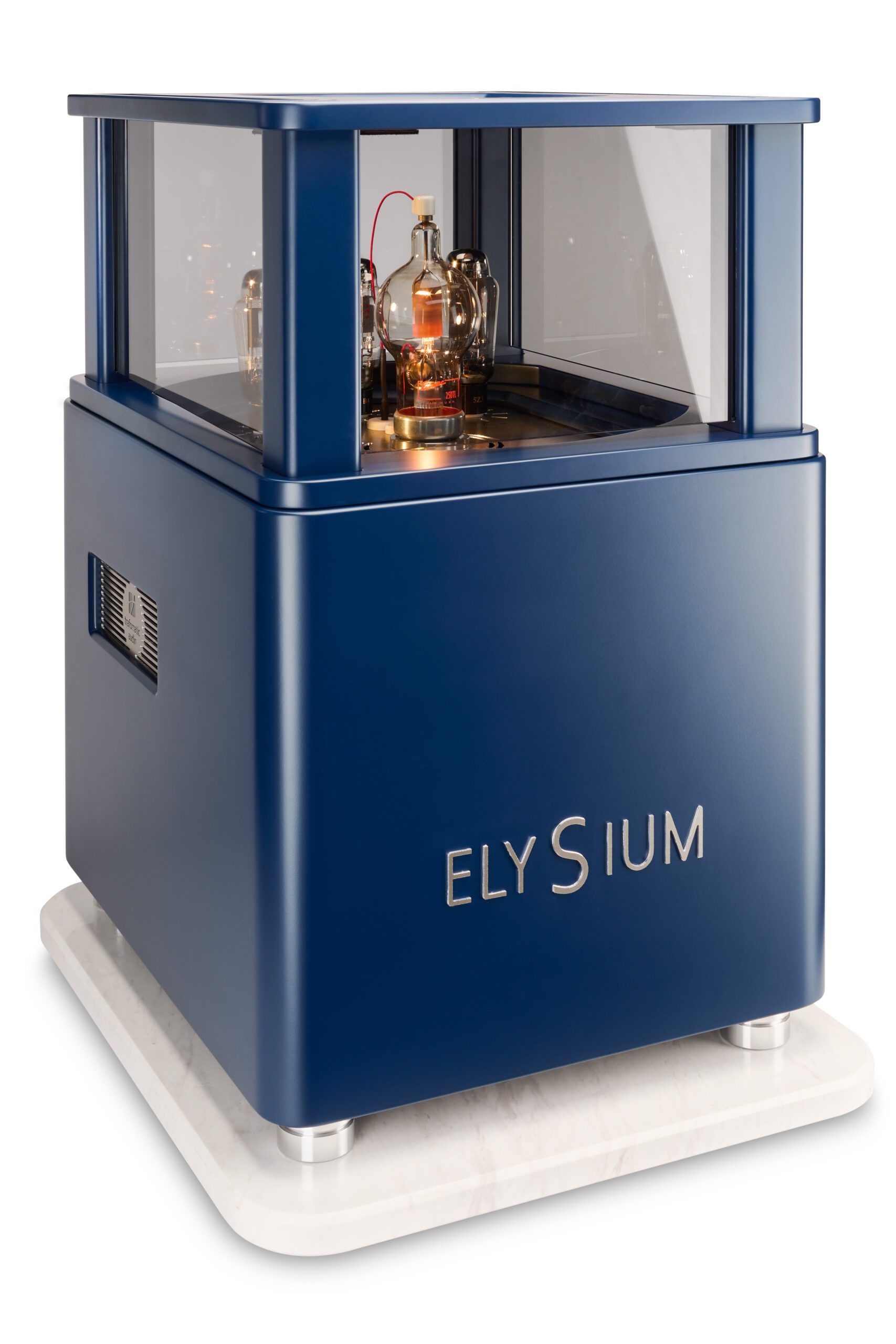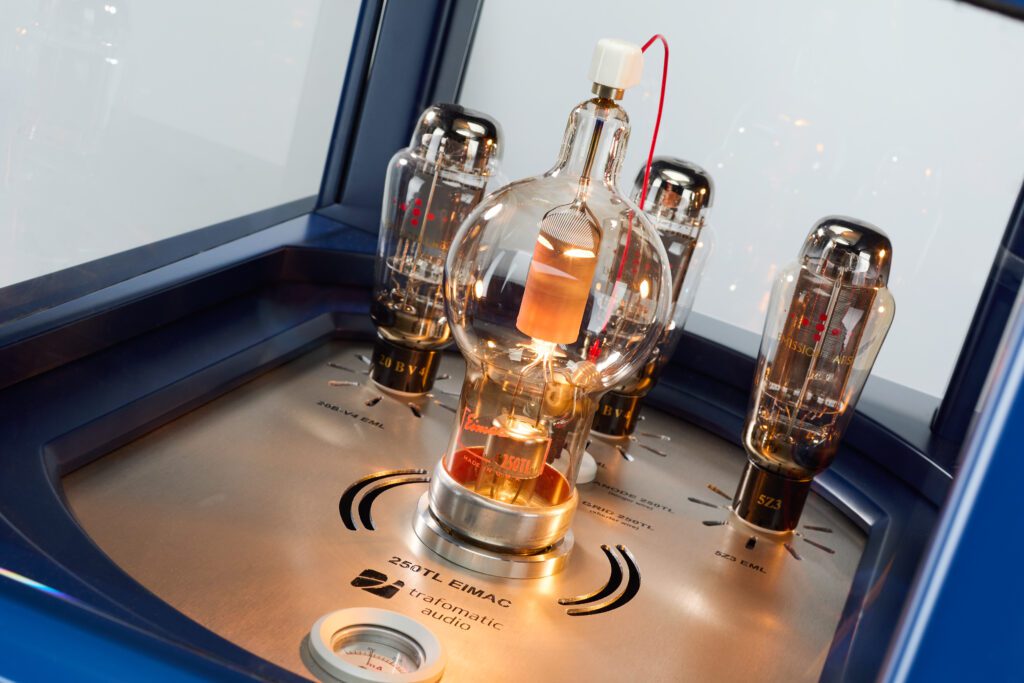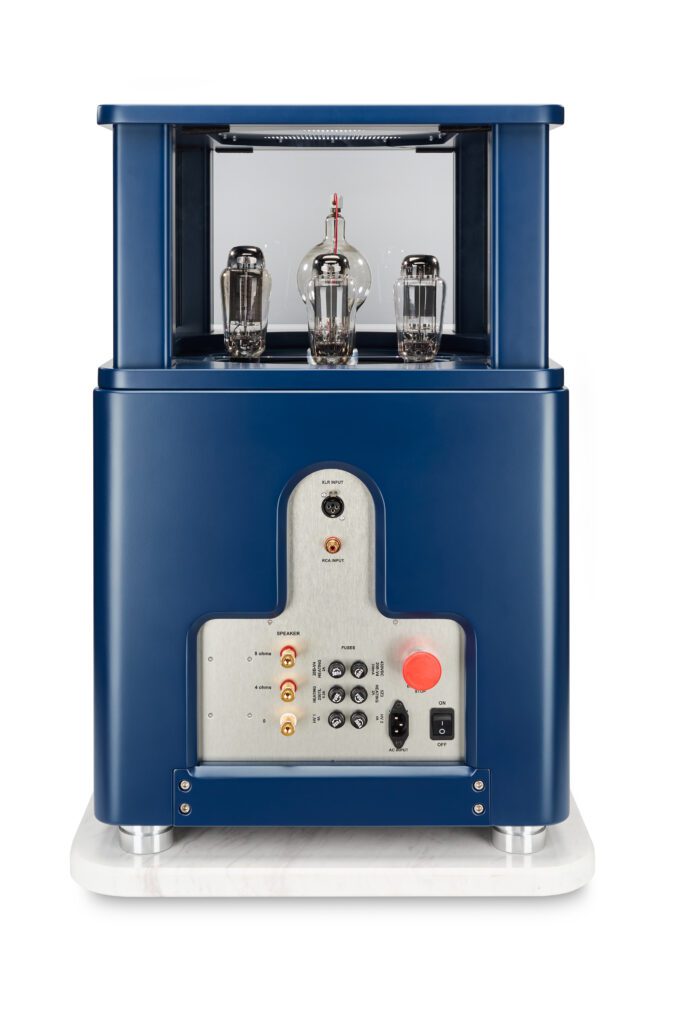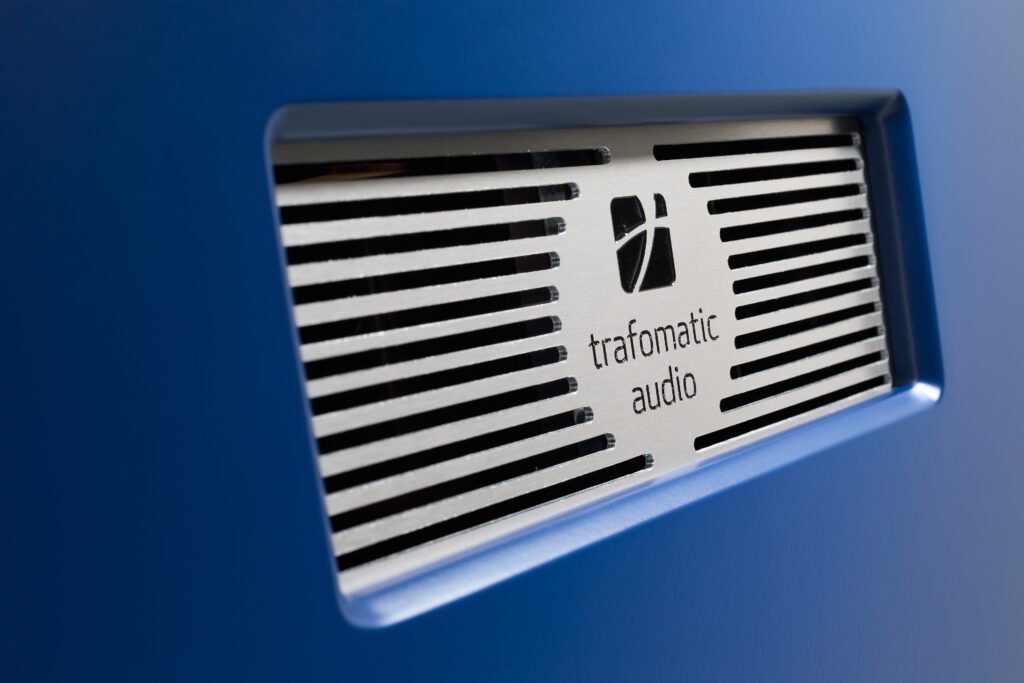
Beginning as a completely conventional review of a completely unconventional valve power amplifier, this view of the Trafomatic Audio Elysium mono amps quickly changed tack. In no small part because of the way it is distributed in the UK (which is very likely a feature in its own right) but also because these products don’t just challenge preconceptions about where the valve amp sits in the pantheon of good audio, it redraws the map of what is possible from every watt an amplifier puts out.
OK so, big valve amplifiers are always something of a statement piece. They are usually large towers of glowing heat, capable of delivering almost unbelievable amounts of power for ‘hollow state’ devices, and their physical characteristics necessitate a large room, often one with a reinforced floor. Even among such lofty company, the Trafomatic Audio Elysium stands out as a unique venture; both the giant Elysium mono power amps and the uncompromising £50,000 Tara30A preamplifier that drives them, in fact.
‘Huh’ moment
Engineer Saša Čokić designs these Serbian giants to be both the ultimate expression of his amplifier designs and the ultimate in valve amplification. While neither preamp nor power amplifier takes the conventional route (the Tara30 uses four single triode power-amp sized valves instead of the usual double triodes and is larger than most integrated valve amps… and if you ask nicely will also be the subject of a review later), the Elysium arguably has the more visible ‘huh?’ moments and those result in the aforementioned landscape-changing aspects of performance.

The Elysium is built around the Elmac 250TL direct heated triode power tube, initially designed for high-frequency transmission. High-end audio has been plundering the cinemas, fighter cockpits and radio stations from the 1930s-1950s to find sublime-sounding valves of high-performance for all kinds of use. It’s how we ended up with valves like the 845 and 211 that have come to dominate single-ended triode power amps from the early 1990s and the Audio Note Ongaku. But even by that heady mix of performance and relative obscurity, the Elmac 250TL is left-field. According to Saša Čokić it’s the most transparent amplifier device ever made. One of these elegant and large valves per chassis is flanked by a EML 20b-V4 direct-heated triode and a EML 5Z3 rectifier valve, both chosen for their linearity.
Of course, you don’t just place these valves into a normal amplifier chassis and power them up. This is the sort of DHT (directly heated triode) design that requires obsessive attention on the part of the designer; do you want an output transformer to match this device? No one makes such a thing, and the minimum order required would fill a warehouse with wire and iron for decades. That would make most manufacturers fall at the first hurdle; Trafomatic Audio instead buys up transformer winding machines, so it can make perfect prototypes and optimally designed units inside each Elysium. Similarly, when using a transmission valve designed to remain powered up for years, turning the thing on and off again will shorten the life of the Elmac 250TL. Again, the result is the sort of soft-start circuit Trafomatic Audio had to design would put off many of the less dedicated, but it’s all in a day’s obsessions!
The power of Ten
This now speaks to why the Trafomatic Audio Elysium is made for Ten Collection and not one of the many other distribution agencies or dealers/distributors in the UK. Ten is like a sort of ‘High-End Privée’, a small group of products that are so specialist and uncompromising that they require some understanding from the buyer as much as everyone else. These products are for the long hauler; the person who’s made their audio bones through years of trying the best products available and is prepared to put in the effort to extract that last scintilla of performance. The person who isn’t just a ‘throw a switch’ type, or someone who is content with either background sounds or sitting glued to their listening chair, but instead, they are for those who’ve earned the right to fill their rooms with a sound that is the real deal, driven by those who know just what it takes to get this close to the live event recreated at home.
The easiest way of describing Ten is by drawing a parallel with food. Some want to eat at the best restaurants they can. Others want to cook with the best ingredients possible in their high-end kitchens. Ten is for those who have got to the point where they have Michelin-starred chefs as friends and invite them over for dinner and a quick cooking masterclass!
This is not simply a price distinction, although inevitably, such uncompromised audio instruments are both hard to get and expensive to buy. None of the products in the Ten portfolio are the sort of things you buy… they are the sort of things you go on a waiting list to buy. And while that buys both exclusivity and bragging rights, it comes with its demands. This brings us back to Elysium.
At face value, Trafomatic Audio’s Elysium’s is single-ended a pure Class A/A1 mono power amplifier. It does have both phono and XLR inputs, but the circuit is inherently single-ended in operation. In Class A mode, the Elysium delivers just 20W, although that rises to 70W in Class A1. Clearly, this is no powerhouse amplifier… but that’s where the Elysium changes the game and redraws the map while shifting the goalposts. That shouldn’t be powerful enough to raise the roof when hooked to relatively demanding loads and is the kind of amplifier that should be crying out for high-efficiency, horn-loaded loudspeaker designs or similar. No one in their right mind would partner an amplifier with not that much power on tap with a loudspeaker like a Wilson Audio Chronomaster XVX or similar, would they? Put simply, the Elysium takes the impossible and makes it possible.
Phenomenally good
Not only can it work with a wider range of loudspeakers than you might expect, it makes a phenomenally good sound in harness this way. You will spend longer waiting for the soft start to gently power up the valves than you will conclude that this amplifier redefines a lot of what we take for granted about ‘neutrality’ and ‘transparency’ in audio devices. Saša Čokič’s bold claim about the Elmac 250TL being the most transparent amplifier device ever made doesn’t seem so ‘bold’… it’s practically self-evident.
Audio enthusiasts who have been around the block a few times often talk of the ‘first watt’; much of the sound of a system is encapsulated in the first few watts of power output, unless we are either ‘caning’ the system and driving it very hard or playing something so extremely dynamic that the swings from quiet to loud draw a lot of power. However, even in that last case, such power draw is instantaneous; an amplifier might notionally need huge reserves of power to cope with something like Rachmaninov’s ‘Symphonic Dances’ [Zinman, Telarc… with the composer’s name spelled ‘Rachmaninoff’], but for most of that piece it might never require much power at all. Moreover, where those brief swings of power demand power, the difference between a few dozen watts of unclipped power and small amounts of even-order harmonic distortion compare well to hundreds of watts with even the smallest amount of clipping and tiny levels of odd-order harmonic distortion, which is both easy to hear and nasty on the ear!

But we’re automatically doing what could be called ‘end-gaining’ instead of ‘means-whereby-ing’. Looking at this relatively rare case where vast swings of power are required, we overlook the performance when they aren’t. And given the Elysium is very good at covering the big dynamic swings and is totally without parallel in those first few watts, the means whereby most music happens in hi-fi is better than ends gained by focusing on the extremes. That might not make sense at first because we are so totally set on those extremes, but not every journey is a drag-race and the unadulterated realism you get from the Elysium and its super-transparent amplifier device makes you wonder if we’ve approached this all wrong!
Terra Incognita
You are probably thumping something and screaming “Yes, but how does it sound?” This highlights why the Elysium places us in terra incognita. This question also highlights why the Elysium – and in a wider context, the whole Ten concept – is not just for casual audio listening. That super-transparent amplifier device and the vast, beautifully made cabinet that wraps around it kills that question stone dead. How does it sound? It sounds like the cables its connected to, or the cartridge, the DAC, the loudspeakers, hell even the juice it’s being fed from the wall. It’s a fully blameless sound; a blank canvas upon which to draw your audio system’s performance. Get it right and it’s like a Kandinsky painting, an abstraction of music perfectly portrayed. Get it wrong and it’s a finger-painting by a drunk!
So, this isn’t and cannot be a conventional ‘review’, as the review process hits its end-stops long before the Elysium happens. Just in logistical terms, an amplifier that requires this degree of care and feeding does not lend itself to fast A/B tests… you’d be spending the better part of an hour in such a test just waiting for it to power up or power down without distress. But much more than that, it depends on the listener and the time they take to assemble a sufficiently qualified system to benefit from the Elysium’s inherent sonic invisibility.
Curiously – and this is the nearest this gets to being a ‘review’ in the normal sense – this need for ‘qualification’ does not apply to the records played through a system that uses the Elysium. No, it’s not forgiving of dynamically compressed and bright pop recordings that plagued the charts from the 1990s onwards, but neither is it brutally unforgiving of their crimes against ears. It presents the music as it was on the recording without exaggeration or masking. Once again holds to the notion of ultimate transparency from the amplifier; nothing is hidden from view, and nothing is exaggerated unless exaggerated elsewhere in the chain. More significantly, however, this works by letting you hear more of that music and hearing it more cogently.

Many of the discs I use for testing have been played hundreds and hundreds of times, to the point where they are almost musically bankrupt, and a series of reference tones for checking specific aspects of a device or system performance. So, when new revelations are unearthed from those recordings it’s a treat. It’s rare if something new is found on one disc, so you realise this is not’ just another high-end’ amplifier when it happens on recording as it did with the Elysium. And when you move to less familiar recordings that aren’t used as test records but are things you play for fun and enjoyment, those aspects are maximised too.
Excitement
You might not get the same “I haven’t heard that before” revelations, but the excitement of listening to music you’ve not heard before swings into play, even with recordings you have heard many times. This is simply a new and better way of perceiving recorded music, one that’s more commonly associated with the live event… which is spectacular because neither Miles Davis nor Jimi Hendrix are touring these days, and Janis Joplin’s concert days are behind her now she’s dead.
The Trafomatic Audio Elysium isn’t just for those who sit in front of a system for hours and hours on end and want to extract the last scintilla of performance and musical enjoyment from their systems. It’s for those for whom music is their lifeblood and want to feel that pumping through their veins. They won’t care that the product is so physically substantial that powering it up or down is more of an activity than an operation or that there’s a substantial waiting list, significant price notwithstanding. They’ll just want a pair. That’s what the Elysium does… it shows you what musical heaven on earth can be like!
TECHNICAL SPECIFICATIONS
- Output power: 70W
- Class of operation: Full DHT SE Class A 20W, Class A1 20–70W
- Tubes complement: 2× 20B-V4 EML,
1× 5Z3 EML , 1× 250TL EIMAC - Inputs: RCA/XLR
- Tubes protection: Wood/glass cover
- Outputs: 4 and 8 ohms
- Input sensitivity: 3.5Vrms
- THD %: 0.3% – 1W/1KHz, 4% – 70W/1KHz
- Frequency bandwidth:10Hz(-2dB)-60KHz( -3dB)
- S/N Ratio: 83dB
- Input impedance: 47K
- Power consumption: 500VA
- Input voltage: 230V/50Hz
(100-120-220-240V available on request) - Size (W×D×H): 620 × 520 × 800mm
- Weight: 85kg per amplifier
- Price: £58,000 per amplifier
Manufacturer: Trafomatic Audio
URL: trafomaticaudio.com
UK Distributor: Ten
URL: ten-collection.com
Tel: +44(0)208 971 3909
By Alan Sircom
More articles from this authorRead Next From Review
See all
Reiki Audio SuperSwitch Master Pro + Servant Pro
- Mar 27, 2024

Melco Audio N1-S38 music server
- Mar 27, 2024

Focal Utopia 2022 headphones
- Mar 27, 2024











